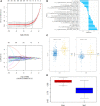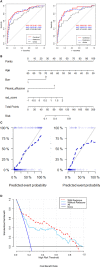A Machine Learning Model Based on PET/CT Radiomics and Clinical Characteristics Predicts ALK Rearrangement Status in Lung Adenocarcinoma
- PMID: 33738250
- PMCID: PMC7962599
- DOI: 10.3389/fonc.2021.603882
A Machine Learning Model Based on PET/CT Radiomics and Clinical Characteristics Predicts ALK Rearrangement Status in Lung Adenocarcinoma
Abstract
Objectives: Anaplastic lymphoma kinase (ALK) rearrangement status examination has been widely used in clinic for non-small cell lung cancer (NSCLC) patients in order to find patients that can be treated with targeted ALK inhibitors. This study intended to non-invasively predict the ALK rearrangement status in lung adenocarcinomas by developing a machine learning model that combines PET/CT radiomic features and clinical characteristics.
Methods: Five hundred twenty-six patients of lung adenocarcinoma with PET/CT scan examination were enrolled, including 109 positive and 417 negative patients for ALK rearrangements from February 2016 to March 2019. The Artificial Intelligence Kit software was used to extract radiomic features of PET/CT images. The maximum relevance minimum redundancy (mRMR) and least absolute shrinkage and selection operator (LASSO) logistic regression were further employed to select the most distinguishable radiomic features to construct predictive models. The mRMR is a feature selection method, which selects the features with high correlation to the pathological results (maximum correlation), meanwhile retain the features with minimum correlation between them (minimum redundancy). LASSO is a statistical formula whose main purpose is the feature selection and regularization of data model. LASSO method regularizes model parameters by shrinking the regression coefficients, reducing some of them to zero. The feature selection phase occurs after the shrinkage, where every non-zero value is selected to be used in the model. Receiver operating characteristic (ROC) analysis was used to evaluate the performance of the models, and the performance of different models was compared by the DeLong test.
Results: A total of 22 radiomic features were extracted from PET/CT images for constructing the PET/CT radiomic model, and majority of these features used were based on CT features (20 out of 22), only 2 PET features were included (PET percentile 10 and PET difference entropy). Moreover, three clinical features associated with ALK mutation (age, burr and pleural effusion) were also employed to construct a combined model of PET/CT and clinical model. We found that this combined model PET/CT-clinical model has a significant advantage to predict the ALK mutation status in the training group (AUC = 0.87) and the testing group (AUC = 0.88) compared with the clinical model alone in the training group (AUC = 0.76) and the testing group (AUC = 0.74) respectively. However, there is no significant difference between the combined model and PET/CT radiomic model.
Conclusions: This study demonstrated that PET/CT radiomics-based machine learning model has potential to be used as a non-invasive diagnostic method to help diagnose ALK mutation status for lung adenocarcinoma patients in the clinic.
Keywords: anaplastic lymphoma kinase (ALK) rearrangement; lung adenocarcinoma; machine learning; positron emission tomography/computed tomography (PET/CT); radiomics.
Copyright © 2021 Chang, Sun, Wang, Yu, Zhao, Ge, Duan, Qian, Wang, Lei, Wang, Liu, Ruan, Yan, Liu, Chen and Xie.
Conflict of interest statement
Authors YG and SD were employed by company GE Healthcare China. The remaining authors declare that the research was conducted in the absence of any commercial or financial relationships that could be construed as a potential conflict of interest.
Figures





Similar articles
-
Clinical, Conventional CT and Radiomic Feature-Based Machine Learning Models for Predicting ALK Rearrangement Status in Lung Adenocarcinoma Patients.Front Oncol. 2020 Mar 20;10:369. doi: 10.3389/fonc.2020.00369. eCollection 2020. Front Oncol. 2020. PMID: 32266148 Free PMC article.
-
Predicting anaplastic lymphoma kinase rearrangement status in patients with non-small cell lung cancer using a machine learning algorithm that combines clinical features and CT images.Front Oncol. 2022 Oct 20;12:994285. doi: 10.3389/fonc.2022.994285. eCollection 2022. Front Oncol. 2022. PMID: 36338735 Free PMC article.
-
Machine learning based on clinico-biological features integrated 18F-FDG PET/CT radiomics for distinguishing squamous cell carcinoma from adenocarcinoma of lung.Eur J Nucl Med Mol Imaging. 2021 May;48(5):1538-1549. doi: 10.1007/s00259-020-05065-6. Epub 2020 Oct 15. Eur J Nucl Med Mol Imaging. 2021. PMID: 33057772 Free PMC article.
-
Molecular typing of lung adenocarcinoma with computed tomography and CT image-based radiomics: a narrative review of research progress and prospects.Transl Cancer Res. 2021 Sep;10(9):4217-4231. doi: 10.21037/tcr-21-1037. Transl Cancer Res. 2021. PMID: 35116717 Free PMC article. Review.
-
A Scoping Review of Machine-Learning Derived Radiomic Analysis of CT and PET Imaging to Investigate Atherosclerotic Cardiovascular Disease.Tomography. 2024 Sep 3;10(9):1455-1487. doi: 10.3390/tomography10090108. Tomography. 2024. PMID: 39330754 Free PMC article.
Cited by
-
AI/ML advances in non-small cell lung cancer biomarker discovery.Front Oncol. 2023 Dec 11;13:1260374. doi: 10.3389/fonc.2023.1260374. eCollection 2023. Front Oncol. 2023. PMID: 38148837 Free PMC article. Review.
-
Prognostic nomogram combining 18F-FDG PET/CT radiomics and clinical data for stage III NSCLC survival prediction.Sci Rep. 2024 Sep 4;14(1):20557. doi: 10.1038/s41598-024-71003-3. Sci Rep. 2024. PMID: 39231973 Free PMC article.
-
Automated data preparation for in vivo tumor characterization with machine learning.Front Oncol. 2022 Oct 11;12:1017911. doi: 10.3389/fonc.2022.1017911. eCollection 2022. Front Oncol. 2022. PMID: 36303841 Free PMC article.
-
Development of a PET/CT molecular radiomics-clinical model to predict thoracic lymph node metastasis of invasive lung adenocarcinoma ≤ 3 cm in diameter.EJNMMI Res. 2022 Apr 21;12(1):23. doi: 10.1186/s13550-022-00895-x. EJNMMI Res. 2022. PMID: 35445899 Free PMC article.
-
Radiogenomics: a key component of precision cancer medicine.Br J Cancer. 2023 Sep;129(5):741-753. doi: 10.1038/s41416-023-02317-8. Epub 2023 Jul 6. Br J Cancer. 2023. PMID: 37414827 Free PMC article. Review.
References
LinkOut - more resources
Full Text Sources
Other Literature Sources

